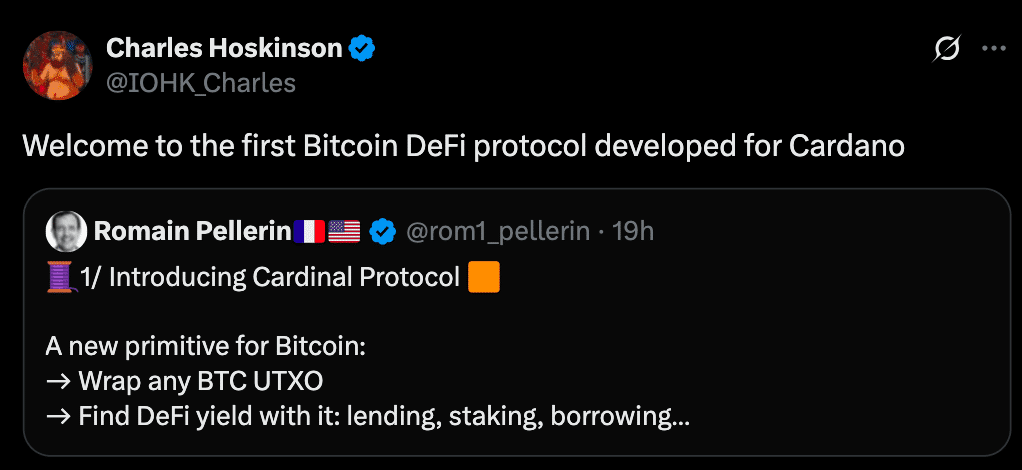According to latest reports, Cardano founder Charles Hoskinson has officially launched the Cardinal Protocol, a first-of-its-kind system enabling Bitcoin DeFi activity on the Cardano blockchain. This is a major leap in decentralized interoperability, providing a custodian-free solution for Bitcoin holders eager to explore DeFi opportunities.
Bitcoin DeFi has long faced limitations due to Bitcoin’s lack of native smart contract capabilities. However, the introduction of Cardinal changes that paradigm by allowing users to engage in lending, staking, borrowing, and farming using Bitcoin on Cardano without depending on third-party custodians.
Wrapped UTXO: Unlocking Bitcoin DeFi Potential
At the heart of Cardinal is the Wrapped UTXO mechanism, which allows Bitcoin holders to mint a tokenized version of their assets for use on the Cardano network. These wrapped tokens can be deployed in a variety of DeFi applications and can be burned at any time to retrieve the original Bitcoin or Ordinals. This system allows for secure, reversible participation in Bitcoin DeFi without sacrificing the decentralization ethos.
Wrapped UTXO forms the bridge between Bitcoin’s robust foundation and Cardano’s smart contract capabilities. By tokenizing unspent transaction outputs (UTXOs), users can unlock new forms of yield and utility while maintaining a trustless environment.

MuSig2 Security and Multichain Compatibility
To further fortify the Bitcoin DeFi ecosystem, Cardinal employs the MuSig2 multi-signature framework, enabling secure peg-in and peg-out functionality. Unlike traditional custodial methods, MuSig2 ensures that transactions are confirmed transparently and cryptographically, reducing the risk of single-point failure or manipulation.
The Cardinal Protocol also introduces multi-chain compatibility, supporting Ethereum, Solana, and Avalanche networks. This expands the reach of Bitcoin DeFi by offering users the ability to engage in cross-chain interactions, enhance asset mobility, and tap into broader liquidity pools without compromising decentralization.
BitVMX Integration and Smart Contract Synergy
Cardinal utilizes BitVMX for off-chain verification, a powerful tool that validates transactions outside the primary blockchain to reduce congestion and increase throughput. BitVMX works seamlessly with Cardano smart contracts, enhancing the user experience in a decentralized but high-speed environment.
Cardinal’s architecture enables users to interact with top Cardano-based DEXs such as MinswapDEX, SundaeSwap, and Fluid Tokens. These platforms allow for Bitcoin DeFi functionalities such as asset swaps, yield farming, and collateralized loans. Ordinals which are Bitcoin-based NFTs or unique tokens, can also be used as loan collateral, auctioned across blockchains, or exchanged while retaining provenance.
Reactions and Real-World Impact
The broader crypto community has responded enthusiastically to Cardinal’s launch. For years, the biggest challenge facing Bitcoin DeFi was trustless compatibility. With Cardinal, users now have a tangible pathway to engage their Bitcoin in decentralized ecosystems without giving up control to centralized custodians or exposing themselves to counter-party risk.
Financial thinkers such as Robert Kiyosaki have long advocated Bitcoin as “people’s money.” Now, through Cardinal, that philosophy becomes operationalized. Bitcoin holders can earn yield, access decentralized lending, and participate in market-making, all while holding onto their core assets.

Cardano’s Role in Evolving Bitcoin DeFi
Cardano’s smart contract architecture provides a fertile environment for Bitcoin DeFi to flourish. As the protocol matures, developers envision Bitcoin assets flowing seamlessly across decentralized ecosystems, from lending pools to insurance vaults and NFT marketplaces.
Cardinal also represents a step in positioning Cardano as a leading DeFi platform that embraces multi-asset liquidity. As Bitcoin remains the largest cryptocurrency by market cap, bringing its value into DeFi markets without custodians could unlock billions in idle capital.
Conclusion: Bitcoin DeFi Enters a New Era
Cardinal Protocol is not just a product—it’s a paradigm shift. By removing custodians and leveraging smart contracts, Cardinal provides a secure, scalable, and interoperable framework for Bitcoin DeFi on Cardano. This aligns with the ethos of decentralized finance: transparency, security, and user empowerment.
As Cardano continues to innovate and add layers to its financial infrastructure, Bitcoin DeFi will likely grow more dynamic, liquid, and inclusive. Hoskinson’s vision of bridging traditional crypto silos is finally materializing, and Cardinal stands at the forefront of this transformation. Follow us on Twitter and LinkedIn, and join our Telegram channel.
FAQs
What is the purpose of the Cardinal Protocol?
Cardinal enables Bitcoin DeFi participation on Cardano without relying on third-party custodians.
How does Wrapped UTXO function?
Wrapped UTXO converts Bitcoin into a tokenized format on Cardano, usable for DeFi purposes like lending and farming.
What makes Cardinal different from other DeFi bridges?
Cardinal uses MuSig2 for trustless transactions and supports multi-chain functionality, enhancing security and flexibility.
Can I reverse a transaction using Cardinal?
Yes, users can burn Wrapped UTXO tokens to redeem their original Bitcoin or Ordinals at any time.
Glossary
Bitcoin DeFi: Decentralized financial services that use Bitcoin as a base asset.
Wrapped UTXO: A tokenized version of Bitcoin on Cardano for use in DeFi.
MuSig2: A multi-signature scheme enabling secure Bitcoin transactions.
BitVMX: Off-chain verification tool for scalable and trustless operations.
Ordinals: Unique digital inscriptions on the Bitcoin blockchain used as NFTs or collateral.





























